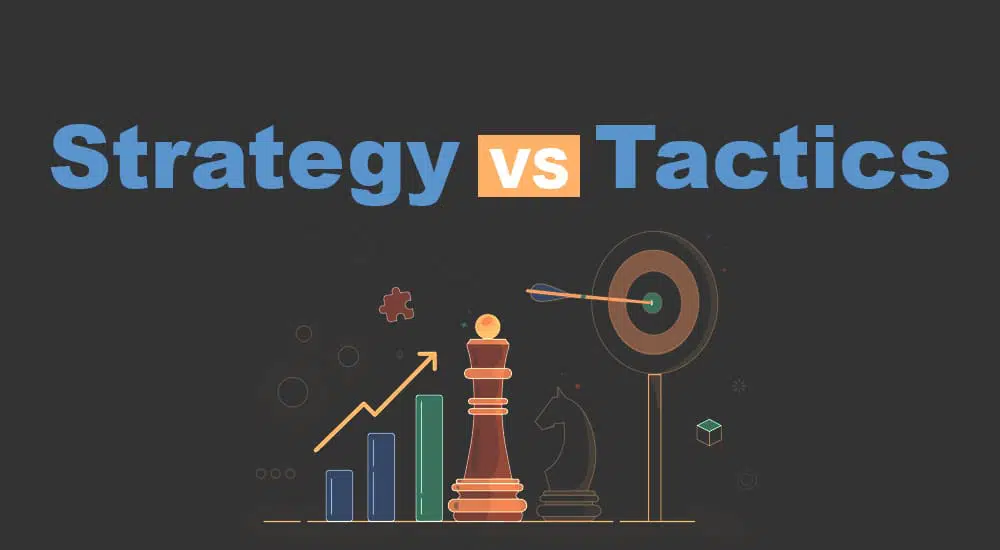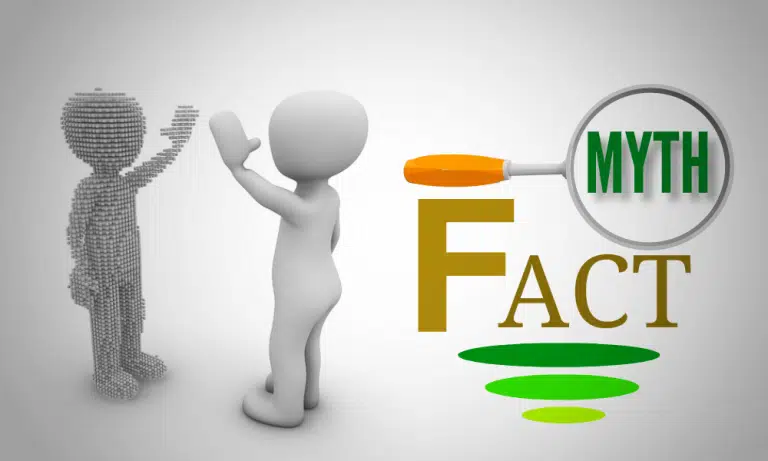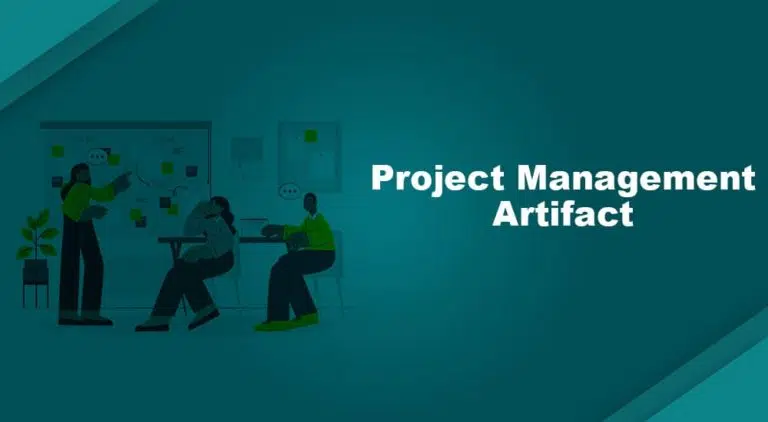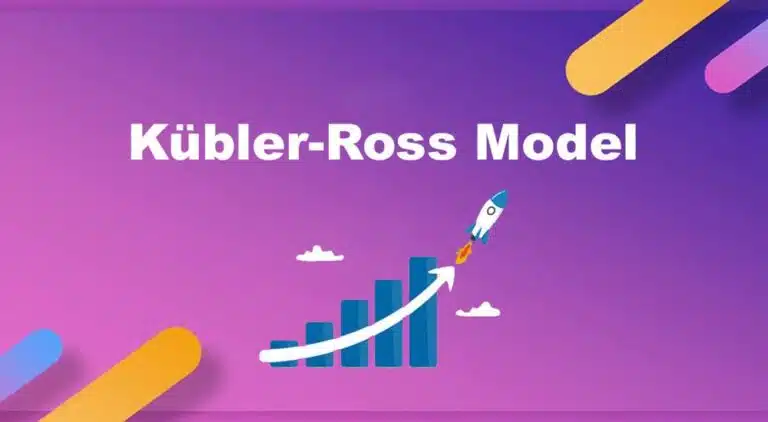Organizations operate to achieve strategic goals; strategies and tactics help them achieve them.
If you have ever been in high-level strategic business planning, you must have heard of strategy and tactics.
Tactics and strategy are different terms, and today’s blog post will discuss strategy vs tactics in detail.
Strategy Vs Tactics
Strategy and tactics do not compete; they complement each other. The strategy shows you the destination, and tactics take you there. In broad terms, you can define strategy vs. tactics as follows:
Strategy is long terms goal that an organization wishes to achieve. It shows the destination that the organization wishes to reach in the long term.
Tactics are the exact steps that lead an organization to the position they want to reach. Tactics involve plans, work assignments, and plan execution.
What is a Good Strategy?
Definition: A strategy is a high-level plan to help the organization define its long-term goals.
The strategy provides long-term direction to an organization. It talks about the future or where the organization is heading. It helps develop an action plan that dictates how an organization will achieve them. Therefore, the strategy should be actionable.
Top executives formulate strategy, focusing on business growth, sustainability, continuity, growth, and market dominance.
Strategy is an organization’s uniqueness in the market. It reflects the value of the organization, and it drives the activities of the organization.
For example, if an organization wishes to achieve uniqueness in the market, all efforts will focus on R&D to develop new and innovative products or services.
Tools for Developing Strategies:
Organizations widely use the following two tools for developing strategies:
- Balanced Scorecard
- Organizational Project Management (OPM)
The Balanced Scorecard (BSC)
The BSC is a performance model that identifies strategy drivers at the highest level. Businesses must ensure that lower-level objectives and measures shown through tactics are consistent with high-level strategies.
A balanced scorecard helps translate a vision into key strategies that businesses can implement to achieve their goals.
Examples of a Balanced Scorecard
Strategy: Be the preferred destination for poultry products in the XYZ community.
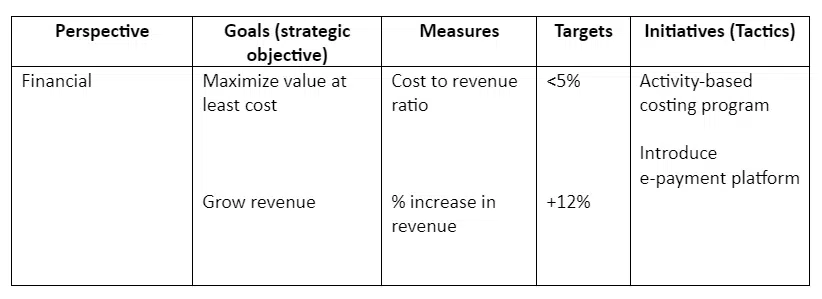
Organizational Project Management (OPM)
The OPM model helps understand the strategic objective of the business. It is a strategic execution framework like the Balanced Scorecard and prioritizes resources. Resources are limited, so organizations prioritize projects or programs.
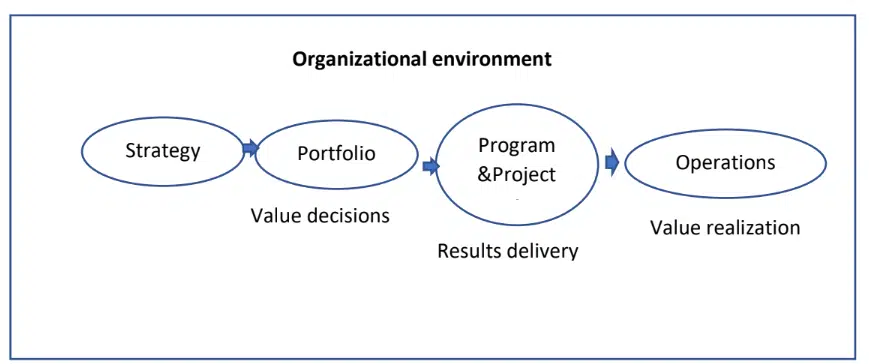
The framework integrates activities that align programs and projects with the organization’s strategy and activities that help transition project results into operations to realize business benefits.
In project management, OPM is used to align projects to organizational strategy. It ensures efficient use of project resources and saves costs by eliminating projects unrelated to the organization’s strategic objective.
Organizational strategy is an input into the company’s OPM.
What are Good Tactics?
Definition: Tactics are actions that help organizations achieve their goals while following the defined strategies.
Good tactics support organizational strategy. They have specific tasks and durations.
Tactics involve the day-to-day activities of the organization. They are short-term approaches and initiatives that add up to achieve the strategy and include specific plans, best practices, etc.
Strategy is the broad, long-term plan to achieve the goal, and tactics are the individual actions that will achieve the goal.
Tactics are the execution part of the strategy.
Success involves the execution (tactics) of a strategy. Therefore, an organization must ensure its tactics align with the strategy.
Businesses execute their strategy through projects. In addition, organizations conduct regular strategic reviews to ensure that individual tasks align with the business’s strategy.
For example, a business that intends to improve its processes and increase efficiency will look for waste, inefficient operation, and outdated processes, replace them with efficient new approaches and adopt best practices.
Key Difference Between Strategy and Tactics
The following are a few key differences between strategy and tactics:
#1. They Have Different Approaches: Strategy and tactics complement each other and align with the organizational goal; however, they have different approaches. Strategy is decided at the top level and guides the whole direction. In contrast, tactics are planned and executed at the lower level to achieve the goal established by the strategy.
#2. They Are Designed for Different Levels: Strategy and tactics are designed for different levels. For example, if the strategy is to get 15% of leads from social media within one year, then the tactics will involve a section of the social media platform, dividing the budget, using marketing techniques, etc.
#3. Affecting Factors: Strategy becomes controlled by external factors such as market conditions, competition, government regulation, etc. On the other hand, tactics are affected by internal organizational factors, such as organizational culture, processes, policies, procedures, etc.
A comparison of strategy and tactics is below.
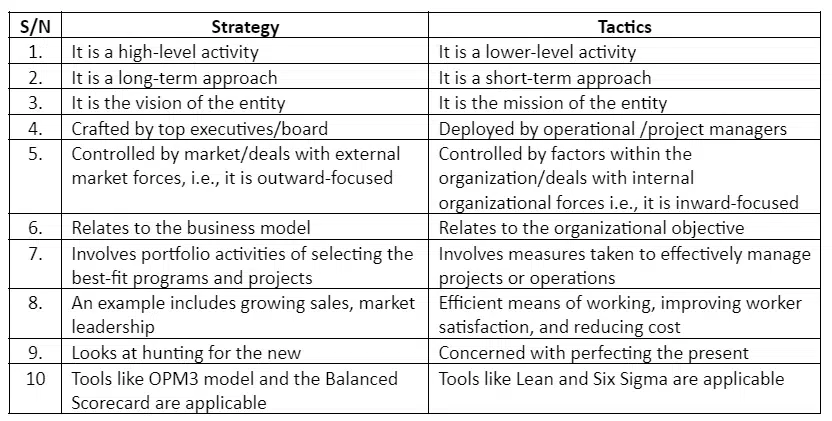
Strategy Vs Tactics Examples
Now, we will see a few examples.
Digital Marketing
The purpose of digital marketing is to increase brand awareness and collect more leads so the business can target them to sell more products and increase sales. As a result, the business can have a goal to increase sales and capture a greater market share.
Strategy: To achieve the goal, one strategy is to increase lead collection by 25%. If you get more leads, you can increase the sale in the same proportion.
Tactics:
- Add a popup lead collection form on a website to collect leads
- Add a sign-up form on all posts
- Offer free case studies to get leads
- Run social media promotions
- Conduct quizzes
Sales
Sales are the backbone of every business. Therefore, a growth-oriented organization has a goal to increase sales and become a market leader.
Strategy: The organization has decided to increase sales by 20% within one year to capture more market share.
Tactics:
- Offer discount
- Offer coupon
- Run social media promotion
- Use TV commercials
- Enter into new markets
Characteristics of a Good Strategy & Tactics
The characteristics of good strategies are as follows:
- Well-Defined Goal: A good strategy has a well-defined and achievable goal
- Backed Up by Data: A good strategy is well-researched and supported by backup data
- Backup Plan: A good strategy must have a contingency and fallback plan if the original strategy gets derailed
- Future-Oriented: Strategies are future-oriented
- Focused on Outcome: Strategies are focused on the outcome
- Requires High-Level Thinking: Top management defines strategies.
- Streamlines Decision-Making: It helps in the decision-making process
- Aligns the Team Towards a Common Goal: Strategies align the organization and project teams towards a common goal
The characteristics of good tactics are as follows:
- Tied to Strategy: Tactics are tied to a strategy, as these are action plans for the strategy
- Short-Term: Tactics are short-term actions to achieve goals
- Time-Bound: Tactics are time-bound to complete
- Actionable: Tactics must be actionable for their completion
- Include all Details: Tactics include all possible details as these are action-oriented
- Present Focused: Tactics are present-oriented
- Are Part of a Larger Plan: Tactics are part of a business’s strategic plan
Skills Required for Developing Strategies and Tactics
Strategies and tactics are developed at different hierarchy levels of organizations and require different skills.
Skills Required for Developing Strategies
The following skills are useful for developing strategies:
- Ability to see a high-level overview of the organization
- Knowing other functions to see how they interlink
- Ability to apply good product and industry expertise
- Ability to work with top management and project teams to implement strategic deliverables
- Ability to communicate the essential business aspects of the project
- Ability to think at the project and portfolio level to understand how proposed projects fit into the business strategy.
Skills Required for Developing Tactics
The following skills are needed to carry out day-to-day tactics in the organization:
- Prioritize and manage time well
- Focus on technical elements of your projects or operations
- Tailoring agile and traditional tools for delivery
- Strong ability to manage critical success factors, schedule, budget, risks, etc.
There are shared skills for both strategic and tactical activities:
- Intrapreneurship
- Negotiation skills
- Communication skills
- Interpersonal skills
How to Track the Progress of Strategy and Tactics?
Strategy and tactics work together to achieve the organizational goal; measuring them regularly is vital to know if the organization is progressing in the right direction.
To measure the strategy and tactics, you must select Key Performance Indicators. KPI quantifies data using metrics and shows you the current status. With this information, you will know if the strategy and tactics lead the business on the determined path.
For example, if the strategy is to increase sales, a KPI can be the lead collection. The metrics will show you how many leads your business has collected and if this collection is ahead or behind the planned collection.
Measuring tactics is easy as they are well-thought plans with start and end dates of tasks and milestones achieving dates.
You can see if the tasks are completed on time or if the team is achieving milestones using your schedule management plan.
Frequently Asked Questions
#1. What is the Main Difference Between Strategy and Tactics?
Strategies are broad and provide high-level guidance to the organization, while tactics are low-level plans to achieve goals set by the strategy.
#2. What Comes First, Strategy or Tactics?
Strategy always comes first and defines the organizational direction. In contrast, tactics are plans to achieve goals.
#3. When To Use Strategy or Tactics?
If an organization needs to create high-level goals, it should go for developing strategies. However, if they have strategies and do not plan to achieve goals, they should go for tactics and develop plans to achieve them.
#4. Which one is more important, Strategy or Tactics?
Both are equally important. Without a strategy, the organization will have no clear goals and objectives and be directionless. Strategies provide long-term organizational goals for the business.
Tactics are steps or processes that help an organization achieve goals. Without tactics, strategies are of no use.
Tactics are equally important as strategy.
Summary
Strategy and tactics are different but complement each other. A strategy has a bigger role, and tactics are part of it. Together they prepare businesses for the future in the face of disruption and fast-changing technology.
References
R. David and H. Norton, The Balanced Scorecard: Translating strategy into actions, Harvard Business School Press, 1996, pg. 289-292.
Managing Change in Organizations: A Practice Guide, Project Management Institute, page. 26-28
https://hbr.org/1996/11/what-is-strategy
https://hbr.org/2022/04/keeping-sight-of-your-companys-long-term-vision?ab=hero-main-text
https://hbr.org/2015/03/strategys-minefield-3
https://www.pmi.org/learning/library/grow-up-already-opm3-primer-8108
https://hbr.org/2006/03/how-to-implement-a-new-strategy-without-disrupting-your-organization

I am Mohammad Fahad Usmani, B.E. PMP, PMI-RMP. I have been blogging on project management topics since 2011. To date, thousands of professionals have passed the PMP exam using my resources.

